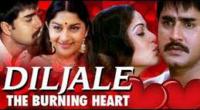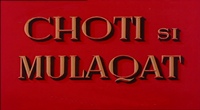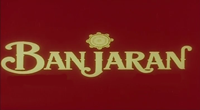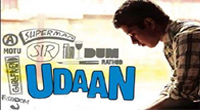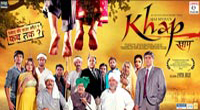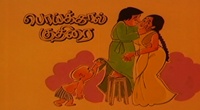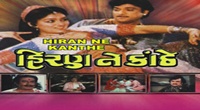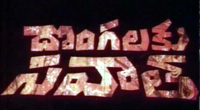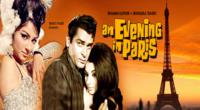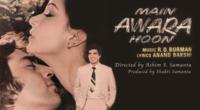Soldier Blue is a 1970 American Revisionist Western film directed by Ralph Nelson and starring Candice Bergen, Peter Strauss, and Donald Pleasence. Adapted by John Gay from the novel Arrow in the Sun by T.V. Olsen, it is inspired by events of the 1864 Sand Creek massacre in the Colorado Territory. Nelson and Gay intended to utilize the narrative surrounding the Sand Creek massacre as an allegory for the contemporary Vietnam conflict.
| Soldier Blue | |
|---|---|
Original theatrical poster | |
| Directed by | Ralph Nelson |
| Produced by | Gabriel Katzka Harold Loeb |
| Screenplay by | John Gay |
| Based on | Arrow in the Sun by Theodore V. Olsen |
| Starring | Candice Bergen Peter Strauss Donald Pleasence |
| Music by | Roy Budd |
| Cinematography | Robert B. Hauser |
| Distributed by | Avco Embassy Pictures |
Release date |
|
Running time | 112 minutes |
| Language | English |
| Budget | $1.2 million (North American rentals) |
Released in August 1970, the film drew attention for its frank depictions of violence, specifically its graphic final sequence. Some film scholars have cited Soldier Blue as a critique of America's "archetypal art form ," with other interpretations ranging from it being an anti-war picture to an exploitation film.
Screenplay
In mid-19th century Colorado Territory, a young woman, Cresta Lee, and young U.S. Private Honus Gant are joined together by fate when they are the only two survivors after their group is massacred by the Cheyenne. Gant is devoted to his country and duty; Lee, who has lived with the Cheyenne for two years, is scornful of Gant (she refers to him as "Soldier Blue" derisively) and declares that in this conflict she sympathizes with them. The two must now try to make it to Fort Reunion, the army camp, where Cresta's fiancé, an army officer, waits for her. As they travel through the desert with very low supplies, hiding from the Indians, they are spotted by a group of Kiowa horsemen. Under pressure from Cresta, Honus fights and seriously wounds the group's chief. Honus finds himself unable to kill the chief and the chief's own men stab him for his defeat and leave Honus and Cresta alone.
Eventually, after being pursued by a white trader, Isaac Cumber, who sells guns to the Cheyenne, but whose latest shipment of weapons Honus has destroyed, Honus finds himself in a cave where Cresta has left him to get help. She arrives at Fort Reunion, only to discover that her fiancé's cavalry plans to attack the peaceful Indian village of the Cheyenne the following day. She runs away on a horse and reaches the village in time to warn Spotted Wolf, the Cheyenne chief. The chief does not recognize the danger and, using the U.S. flag, rides out to extend a hand of friendship to the American soldiers. The soldiers, however, obey the orders of their commanding officer to open fire on the village.
After a cavalry charge decimates the Indian men, the soldiers enter the village and begin to rape and kill the female survivors. Honus protests and attempts to disrupt the massacre, to no avail. Cresta attempts to lead the remaining women and children to safety, but her group is discovered and massacred, though Cresta herself is spared. After the battle, Honus is led away in shackles and Cresta departs with the remaining few survivors.
- Candice Bergen as Kathy Maribel 'Cresta' Lee
- Peter Strauss as Honus Gant
- Donald Pleasence as Isaac Q. Cumber
- John Anderson as Colonel Iverson
- Jorge Rivero as Spotted Wolf
- Dana Elcar as Captain Battles
- Bob Carraway as Lieutenant McNair
- Martin West as Lieutenant Spingarn
- James Hampton as Private Menzies
- Mort Mills as Sergeant O'Hearn
- Jorge Russek as Running Fox
- Ralph Nelson (credited as Alf Elson) as Agent Long
The film provided the first motion picture account of the Sand Creek massacre, one of the most infamous incidents in the history of the American frontier, in which Colorado Territory militia under Colonel John M. Chivington massacred a defenseless village of Cheyenne and Arapaho on the Colorado Eastern Plains.
The account of the massacre is included as part of a longer fictionalized story about the escape of two white survivors from an earlier massacre of U.S. Cavalry troops by Cheyenne, and names of the actual historical characters were changed. Director Nelson stated that he was inspired to make the film based on the conflicts in Vietnam and Songmy.
Principal photography began on October 28, 1969, with exterior photography taking place in Mexico. Arthur Ornitz was originally hired as the film's cinematographer, but was replaced by Robert B. Hauser several weeks into production. According to actress Bergen, a large van full of prosthetics was brought in during the filming of the violent battle sequences, full of dummy body parts and animatronics. Additionally, amputees from Mexico City were hired to serve as extras during the final massacre sequence.
Soldier Blue premiered in New York City on August 12, 1970, and opened in Los Angeles two days later on August 14, 1970.
Box office
The film was the third-most popular film at the British box office in 1971. It brought $1.2 million from the U.S./ Canada rentals. The title song, written and performed by Buffy Sainte-Marie, was released as a single and became a top ten hit in the UK as well as other countries in Europe and Japan during the summer of 1971.
Contemporaneous
Multiple film critics said Soldier Blue evoked the My Lai massacre, which had been disclosed to the American public the previous year. In September 1970, Dotson Rader writing in The New York Times, remarked that Soldier Blue "must be numbered among the most significant, the most brutal and liberating, the most honest American films ever made."
Roger Ebert of the Chicago Sun-Times wrote of the film: "Soldier Blue is indeed savage, but it wears its clock of "truth" self-consciously. It is supposed to be a pro-Indian movie, and at the end the camera tells us the story was true, more or less, and that the Army chief of staff himself called the massacre shown in the film one of the most shameful moments in American history." He added: "So it was, and of course we're supposed to make the connection with My Lai and take Soldier Blue as an allegory for Vietnam. But that just won't do. The film is too mixed up to qualify as a serious allegory about anything." The Time Out film guide called the film "a grimly embarrassing anti-racist Western about the U.S. Cavalry's notorious Sand Creek Indian massacre in 1864. In the interests of propaganda, one might just about stomach the way the massacre itself is turned into a gleefully exploitative gore-fest of blood and amputated limbs; but not when it's associated with a desert romance that's shot like an ad-man's wet dream, all soft focus and sweet nothings."
Contemporary
Modern critics and scholars have alternately described Soldier Blue as an anti-Western, revisionist Western, "anti-American," and as an exploitation film. In 2004, the BBC named it "one of the most significant American films ever made." British author and critic P.B. Hurst, who wrote the 2008 book The Most Savage Film: Soldier Blue, Cinematic Violence and the Horrors of War, said of the film:
A good number of critics in 1970 believed that Soldier Blue had set a new mark in cinematic violence, as a result of its graphic scenes of Cheyenne women and children being slaughtered, and had thus lived up – or down – to its U.S. poster boast that it was "The Most Savage Film in History." A massive hit in Great Britain and much of the rest of the world, Soldier Blue was, in the words of its maverick director, Ralph Nelson, "not a popular success" in the United States. This probably had less to do with the picture's groundbreaking violence, and more to do with the fact that it was the U.S. Cavalry who were breaking new ground. For Nelson's portrayal of the boys in blue as blood crazed maniacs, who blow children's brains out and women, shattered for ever one of America's most enduring movie myths – that of the cavalry as good guys riding to the rescue – and rendered Soldier Blue one of the most radical films in the history of American cinema. The film's failure in its homeland might also have had something to do with the perception in some quarters – prompted by production company publicity material – that it was a deliberate Vietnam allegory.
Retrospective analysis has placed the film in a tradition of motion pictures of the early 1970s—such as Ulzana's Raid (1972)—which were used as "natural venues for remarking on the killing of women and children by American soldiers" in light of the political conflicts of the era. However, the "visual excesses" of the film's most violent sequences have been similarly criticized as exploitative by modern critics as well.
In a 2005 article on the film in Uncut, Kevin Maher deemed it "a bloody 1970 exploitation western ... has a gore-count worthy of Cannibal Holocaust." Paul Mavis, reviewing the DVD release of Soldier Blue for DVD Talk in 2006, wrote: "ith no attempt to fairly intellectualize the proceedings, Soldier Blue winds up only celebrating the barbarities it so lovingly depicts. As the posters accurately insinuate, Soldier Blue is essentially nothing more than a snuff film with a conscience...and a particularly suspect conscience at that." Similarly, TV Guide awarded the film one out of five stars, writing: "Soldier Blue suffers from Bergen's weak performance and Strauss is bland, but the parallel between the 1864 Sand Creek Massacre and Vietnam's My Lai incident is disturbing and the film's depiction of Native American life is an explicite attempt to move past Hollywood stereotypes."
Film scholar Christopher Frayling described Soldier Blue as a "much more angry film" than its contemporary Westerns, which "challenges the language of the traditional Western at the same time as its ideological bases." Frayling also praised its cinematography and visual elements in his 2006 book Spaghetti Westerns: Cowboys and Europeans from Karl May to Sergio Leone: "most critics succeeded in missing the really inventive sections of Soldier Blue, which involve Nelson's use of elaborate zooms, and of untraditional compositions, both of which subtly explore the relationship between the 'initiates' and the virgin land which surrounds them."
Recalling the film, star Candice Bergen commented that it was "a movie whose heart, if nothing else, was in the right place."
- List of American films of 1970
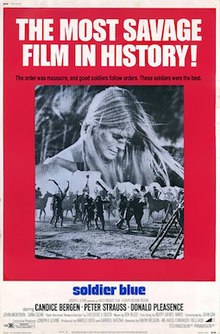 Story of movie Soldier Blue :
Story of movie Soldier Blue : 

